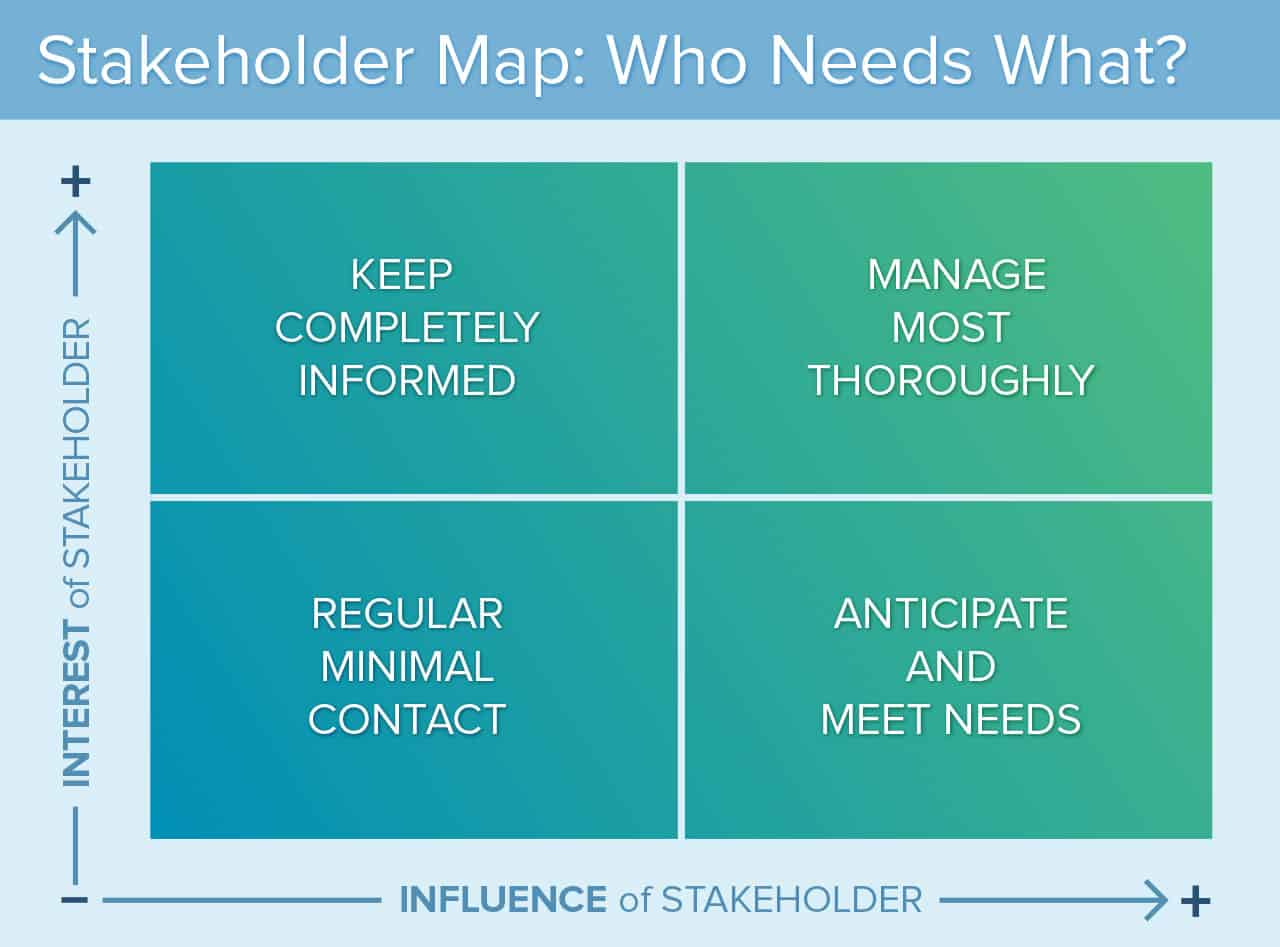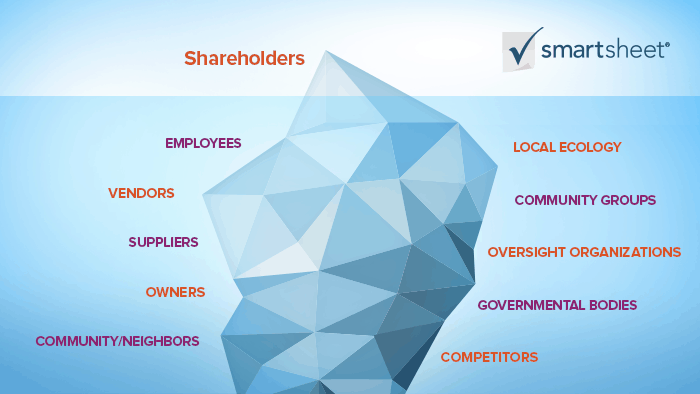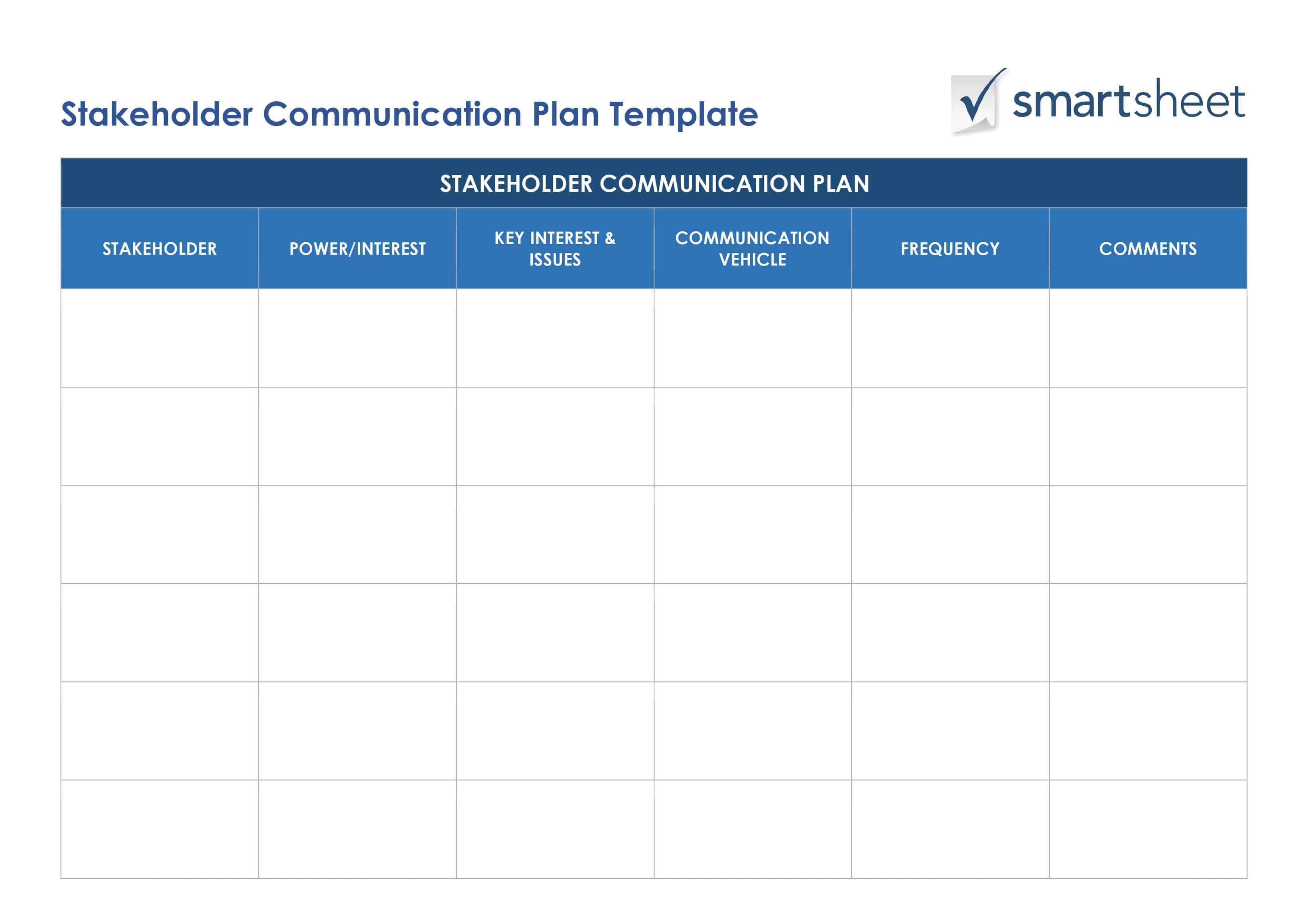Definitions: Corporate vs. Project Stakeholder Management
For optimal results in any project, it’s critical to identify your key corporate and project stakeholders. Once you have identified these stakeholders in a stakeholder matrix that weighs their respective needs and influence, you can begin to assess how to manage them.
A project stakeholder is anyone working directly or indirectly on or with your project. These include the project manager and program manager, as well as the project team. Members of the team can include creatives, manufacturers, technical developers, construction workers, electricians - anyone whose work will be needed, at some point, during the project. Additional stakeholders may include liaisons from another company hired for the project; anyone directly involved in the project on that company’s side is also a project stakeholder.
If you’re working on an internal project, you’ll likely have corporate stakeholders from one company. For example, if a small grocery chain decides to open a new store, the project stakeholders would be anyone involved directly in building and staffing that new location, and the corporate stakeholders would be the company’s executives, board of directors, marketing and PR staff, quality control people, etc.
In more complex projects, such as one in which a company engages an agency to create designs, copy, and technical requirements for a website, there would be corporate stakeholders in the hiring company as well as the agency doing the project work. We’ll discuss more about those roles later in this article.
Once you have identified your project and corporate stakeholders and have mapped them according to their influence and interest, you can begin to create your stakeholder management plans. Each plan can be a simple grid: one lists the project stakeholders and one lists the corporate ones (including individual roles and interests). Once this essential information is captured in this easy-to-scan document, you and your team members can easily see how each stakeholder should be managed.
Communicating with stakeholders and keeping the right people in the loop (at the right stages of your project, with the right amount of detail) is critical to making everyone feel valued, involved, and heard. The stakeholder communications plan for each type of stakeholder should should reflect and align with the stakeholder management plan.
Who Is a Project Stakeholder? Anyone Who Directly Touches the Project
For more on stakeholders, read our stakeholder analysis and mapping article and our stakeholder theory article. To help you get started, here is a list of people who could be project stakeholders:
- Internal: The project team, including contractors and vendors, as well as resourcing directors, accounting department members, and others who want to see the project run efficiently and profitably. On an internal company project, there will be a small number of critical leaders who are considered the key stakeholders.
- External: If you and your company have been hired by another company or client for a project, your external project stakeholders include the main client team, their managers, and their division director. In an agency environment, typically there are one or two stakeholders identified as a liaison from the client project team.
Here is a simple matrix/map that can help you get started. As you and your team brainstorm your stakeholders, jot their names into the appropriate area of the map. Over the course of a project, you may find that stakeholders’ interest and influence change during different phases, or that some are more involved and critical at the beginning of a project, and some will be toward the end or even after the project is launched.
You can also use this matrix to help you map out the corporate stakeholders; more on that below.
Who Is a Corporate Stakeholder? Managers, Executives, and More
It’s important to identify (and create a management plan for) corporate stakeholders on your project. These might be people you would never meet in a typical day or week while working on your project, but they have an interest or an investment in its success. Let’s talk about some of the typical types of corporate stakeholders. Don’t forget: if your project involves doing work for another company, there can be stakeholders from more than one corporation. You will have corporate stakeholders in both companies. Here is a list of people who could be corporate stakeholders:
- Internal Corporate Clients: These stakeholders can overlap with your project clients, but can make up a wider pool of people. For instance, if your project client stakeholders are part of a big division at their company, the executives of that division are also stakeholders.
- Management: Again, managers can be simply in your company if the project is an internal one, or in more than one if your project involves doing business with one or more other organizations. The managers of all of these organizations are stakeholders who want your project to run on time and on (or under) budget, and are also mindful of public relations implications, if any, related to the project.
- Board of Directors: These stakeholders may not have much visibility into the nuts and bolts of your project and its lifecycle, but just like high-level management, they want to be assured that everything undertaken by the company - including your project - is done by the book, on time, and with great results.
- Shareholders: A publicly held company is beholden to its shareholders who want to see a profit, but may also want to be sure the company in which they hold shares is acting ethically and responsibly. For example, a publicly traded electric company building a wind farm may make some shareholders happy and some less so, depending on variables like how valued renewable energy is, the cost outlay and how quickly investments can be recouped, and whether there has been mitigation undertaken for environmental and wildlife impact and more.
Stakeholder Strategies: Who Needs What and When?
Once you have identified all the types of project and corporate stakeholders related to your project, you can plan how to manage them. This is where it’s important to ask key questions, and to be as honest as you can in assessing your stakeholders and their needs.
Important Factors to Consider - An Exercise for Both Project and Corporate Stakeholders
- Who are the stakeholders who have the most influence on your project? These will include mostly client-side people - typically their project team, the project sponsor, and the executive sponsor.
- Which stakeholders will be most affected by your project? This can include people from the first group, but may also include outside people. With a construction project, for example, those in the neighborhood, environmental activists, and potential residents of the final building could be in this group.
- How should you handle important people who aren’t considered stakeholders? For instance, in your software project, there may be executives elsewhere on the software team who are department leaders, and who may need to be kept in the loop on certain things. Keep these people minimally involved since they could have the power to raise concerns or create roadblocks.
- Who controls the resources? These will be client-side and internal stakeholders who you contact to request a scope or budget change, or request more allocated resources from a certain discipline.
- What are the top motivations and interests of your stakeholders? When deciding the driving force of stakeholders consider:
- Who has a financial stake/interest.
- Who has an emotional interest (don’t underestimate this; if this project was someone’s “baby,” keeping them happy and informed is critical).
- What are the top motivations for each stakeholder.
- Who are the biggest supporters.
- Who are the biggest non-supporters or naysayers.
Stakeholder Ethics and Stakeholder Theory
Stakeholder theory was first described by Dr. F. Edward Freeman, a professor at the University of Virginia, in his book, Strategic Management: A Stakeholder Approach. He suggests that shareholders are merely one of many stakeholders in a company. According to his theory, the stakeholder ecosystem involves anyone who is invested, involved in, or affected by the company: employees, environmentalists, vendors, governmental agencies, and more. Dr. Freeman’s theory says that a company’s real success lies in satisfying all its stakeholders, not just those who might profit from its stock.
Dr. Freeman suggests that a company’s stakeholders are "those groups without whose support the organization would cease to exist." These groups include customers, employees, suppliers, political action groups, environmental groups, local communities, the media, financial institutions, governmental groups, and more. This view paints the corporate environment as an ecosystem of related groups, all of whom need to be considered and satisfied to keep the company healthy and successful in the long-term.
Dr. Freeman’s books describe how a healthy company never loses sight of everyone involved in its success. Stakeholder theory says that if a company treats its employees badly, it will eventually fail. If a business forces its projects on communities to detrimental effects, the same would likely happen. “A company can’t ignore any of its stakeholders and truly succeed,” said Dr. Freeman.
Therefore, it’s important to remember to identify and include all of these “extended” stakeholders as you proceed with your project and corporate stakeholder management plans.
The New Stakeholder ‘Paradigm’: Broad Inclusion
In their book Stakeholders Matter: A New Paradigm for Strategy in Society, coauthors Sybille Sachs and Edwin Rühli argue that corporate and project stakeholders have, or should have, increasingly similar needs and interests. The view expands upon Freeman’s stakeholder theory, and is especially relevant to managing both project and corporate stakeholders.
In other words, corporate stakeholders and project stakeholders are already far more aligned in their interests, their definitions of success, and their definitions of risk or failure. Sachs added that managing stakeholders should be “considered in a holistic environment of mutuality.” In this view, project stakeholders would be as invested, for instance, in the PR ramifications of a wind farm project as they are in whether the project is constructed on time and on budget.
Creating a Stakeholder Management Plan, for Project and for Corporate Stakeholders
After you identify your stakeholders, you’ll need to capture how best to manage them. A stakeholder management plan can be a basic grid or spreadsheet that lists the stakeholders along one axis and their points of interest and influence along the other. In the individual boxes, note key milestones or deliverables that stakeholder might have special interest in, as well as financial and emotional needs tied to the project.
The project manager or account director may create and maintain the stakeholder management plan. However, the plan is usually most effective if it’s shared among the project team, especially those who meet regularly with stakeholders. In some cases, the plan is also shared with top managers. A stakeholder management plan is not typically shared with the actual stakeholders listed.
A stakeholder communication plan should list the key stakeholders who need to receive communications, including type, frequency, and detail. It may make sense to do the communications plan immediately after the management plan, or as two parts of the same plan. Some corporate stakeholders may be happy with a monthly high-level email; some may want a quarterly meeting with a more formal presentation. Project stakeholders, on the other hand, may require more frequent updates.
Getting the Right Roadmap for Project and Corporate Stakeholders
Now you should have enough information to begin identifying the management requirements for each of your stakeholders and stakeholder groups. Using one grid for your project stakeholders, and another for your corporate ones will help keep things clearer. To create a management plan, list all your stakeholders along one side of the grid, typically the far-left column; and the factors and needs and interests along the top.
Stakeholder Management Plan Example – A building project for a wind farm for electric power for a regional electrical utility
Stakeholder Communications: Who Needs to Know What and When?
As you identify your stakeholders, and how they need to be managed most efficiently, you’ll have the beginnings of your communications plan. Begin with a simple grid with the ranked stakeholders, and add the types of communications they would expect and need.
When you are creating this plan, be mindful that high-level executives want to be well informed about the status of high-profile projects, but their time is very precious. A good project manager knows how to balance communications that keep someone important informed, but not overwhelmed with granular details. Likewise, “extended” stakeholders don’t need access to everything about the project, as long as they feel they are being heard and have input. Here is a sample plan:
Download Stakeholder Communication Plan Template - WORD
The grid could include review rounds of copy and design as well as daily, weekly, or monthly updates on progress, budget, and upcoming tasks.
You can share the communications plan by saving the grid to a shared drive, and use an automated tool to email the right people updates at the right frequency. You might do a weekly high-level report for key stakeholders via a personal email from the project manager. Project stakeholders likely will also want to see a burn report - hours forecasted vs. hours spent, and time likely to be spent in the near future.
Some stakeholders (like the executive leads) may need a more formal type of communication, but less frequent. Perhaps those stakeholders would prefer a monthly PowerPoint presentation that reports on the status, the features and updates that have been completed, the input and feedback that’s been received to date, and so on.
Think ahead about how feedback from stakeholders will be handled. If there is a timeline change in the wind farm project, for instance, which stakeholders need to know that, and in what fashion? If a big storm causes damage, again, who needs to be apprised, and how? Also consider how you’ll communicate positive events, like, for example, a local environmental group releasing a statement saying it’s pleased with the wildlife protection guidelines the utility has put in place.
Benefits of a Stakeholder Communication Plan
Maintaining strong, succinct lines of communication throughout a project is key to keeping it running smoothly, and instilling confidence in both project and corporate stakeholders. When you create and execute detailed communications plans, you will:
- Feel confident and prepared. You can always be prepared and two steps ahead in planning on how and when to communicate to your important stakeholders. A project manager that is on top of things and strategic is a project manager that inspires confidence from her stakeholders.
- Anticipate the needs of stakeholders and answer them before they become issues. If you have a regular cadence for communications, you already have a vehicle for sharing news and updates, and for reducing any risks or confronting any roadblocks.
- Be able to share information and updates clearly and appropriately. Granting access to the whole team - perhaps even creating a section for project team notes and suggestions - gives everyone a feeling of ownership and accountability.
- Know that the plan can be organic as new stakeholders come and go, or as their individual involvement changes. The plan exists to help you and your project team inspire confidence from your stakeholders, so make sure you develop an organic document.
Smartsheet Can Help You Create Stakeholder Management and Communication Plans
From simple task management and project planning to complex resource and portfolio management, Smartsheet helps you improve collaboration and increase work velocity -- empowering you to get more done.
The Smartsheet platform makes it easy to plan, capture, manage, and report on work from anywhere, helping your team be more effective and get more done. Report on key metrics and get real-time visibility into work as it happens with roll-up reports, dashboards, and automated workflows built to keep your team connected and informed.
When teams have clarity into the work getting done, there’s no telling how much more they can accomplish in the same amount of time. Try Smartsheet for free, today.




